|
Jazz Essentials, Part 2
Unearthing the very roots of
jazz
By Tom Ineck
In our first offering of recordings essential
to any jazz collection, we took a look at five releases from 1959, a
logical choice in their 50th anniversary year. But as the
decade turns, 2010 calls for a more definitive, long-range perspective,
a look at some worthy examples of the early development and refinement
of a great American art form that is approaching a century of recorded
history.
Several artists suggest themselves—without
doubt—as important and influential architects of jazz in the 1920s and
1930s. Louis Armstrong was the seminal jazz improviser, putting the
soloist in the spotlight and creating an exciting vocal technique that
was part and parcel of that individual sound. Employing a larger
ensemble, Duke Ellington used elegant and sophisticated melodies and
orchestral arrangements as lush backdrops for his soloists. Count Basie
took a simple, riff-based blues form and generated a mighty, horn-driven
swing engine that was irresistibly popular among musicians and
listeners. Benny Goodman broadened the scope of the swing movement by
attracting a younger, whiter audience while continuing to feature some
of the best jazz arrangers and soloists available. Django Reinhardt
created a new swing vocabulary for stringed instruments, resulting in
the effervescent “gypsy jazz.”
Because
early jazz artists operated in the pre-LP era, their music was recorded
in more piecemeal fashion, first on cylinders then on 78 rpm discs that
usually contained two tunes on each side. In recommending some of the
best of these classics in the current CD era, one need only point to the
outstanding compilations, often available in multi-disc boxed sets.
LOUIS ARMSTRONG
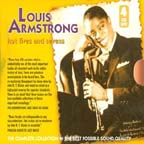 The
Hot Fives and Sevens The
Hot Fives and Sevens
JSP
Records
These
definitive small-group recordings, made between 1925 and 1930, have been
released in numerous configurations by many different labels, including
Columbia. The four-CD, 90-track JSP edition, released in 1999, gets the
nod for its sound fidelity, its more logical sequencing and the small,
independent label’s devotion to the music.
Armstrong
formed the first all-star studio jazz band in history—the Hot Five—while
still working as a featured big-band soloist. The band also included
Johnny Dodds on clarinet, Kid Ory on trombone, Johnny St. Cyr on banjo
and Armstrong’s wife, Lil Hardin Armstrong, on piano. Together, they
work their magic as a seamless whole, nearly bursting with enthusiasm
and instrumental virtuosity in a broad range of material that
encompasses both the direst blues and the most joyous stomps this side
of paradise.
Expanding
the ensemble to the Hot Seven, Armstrong included such brilliant
collaborators as pianist Earl “Fatha” Hines, trombonist Jack Teagarden
and guitarist Lonnie Johnson. Hines sophisticated style is especially
noteworthy in his monumental duets with Armstrong.
In brief,
these recordings are the equivalent of the Holy Grail of jazz history.
Considering their age, the sound quality is excellent and JSP is to be
commended for this reasonably priced package.
DUKE ELLINGTON
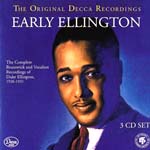 Early
Ellington: Complete Brunswick and Vocalion Recordings Early
Ellington: Complete Brunswick and Vocalion Recordings
Verve
Records
This
three-disc package, released on Verve in 1994, documents Ellington’s
phenomenal artistic genius as his various ensembles emerged and
developed from 1926 to 1931, in recordings on the Brunswick and Vocalion
labels. In guises ranging from the Kentucky Club Orchestra, the Cotton
Club Orchestra and the Washingtonians to the Jungle Band, the Hotsy
Totsy Gang and the Six Jolly Jesters, Ellington introduced such classics
as “East St. Louis Toodle-oo,” “Black and Tan Fantasy,” “The Mooche,”
“Rockin’ in Rhythm,” “Creole Rhapsody” and “Mood Indigo.”
Of course,
it was Ellington’s featured soloists who made his sound so personal.
Emerging here with their own unique voices are trumpeters Bubber Miley
and Cootie Williams, trombonist “Tricky” Sam Nanton, clarinetist Barney
Bigard, alto saxophonist Johnny Hodges, and baritone saxophonist Harry
Carney.
With 67
tracks and more than three hours of music, this set is an excellent
overview of Ellington’s early years, as he wrote his first, very
important chapter in the history of jazz. Of course, he would go on to
other significant contributions, but this is where it all began.
COUNT BASIE
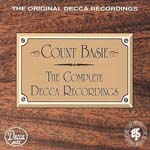 The
Complete Decca Recordings The
Complete Decca Recordings
Verve
Records
Basie’s
early fame can be traced to these 63 classic recordings for Decca.
Recorded between 1937 and 1939 and released in 1992 by GRP Records on
three discs, they are now available on the Verve label. Every track
swings with that special pumping exuberance that the Kansas City style
epitomizes.
Like
Ellington, Basie often took a back seat to his remarkable soloists—among
them, Lester Young and Herschel Evans on tenor saxes, and Harry “Sweets”
Edison and Buck Clayton on trumpets. Driving the whole band, of course,
is the extraordinary rhythm section of Basie, guitarist Freddie Green,
bassist Walter Page and drummer Jo Jones. Singer Jimmy Rushing adds his
uncanny blues vocals to several tracks, and Helen Humes is an elegant
contrast with her more pristine vocal style.
Among the
essential tunes of the Basie catalog included here are “One O’Clock
Jump,” “Time Out,” “Good Morning Blues,” “Boogie Woogie (I May Be
Wrong),” “Swingin’ the Blues,” “Blue and Sentimental,” “Jumpin’ at the
Woodside,” and “Jive at Five.”
BENNY GOODMAN
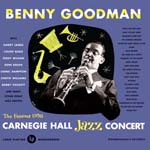 Carnegie
Hall Jazz Concert Carnegie
Hall Jazz Concert
Columbia/Legacy Records
Rather than
choose a broad retrospective of Goodman material, such as the excellent
two-disc, 2007 Sony release “The Essential Benny Goodman” or the 1991
three-CD collection of early Bluebird recordings called “The Birth of
Swing (1935-1936),” I recommend this somewhat flawed 1999 reissue of the
famous Carnegie Hall concert of January 1938, which put Goodman on the
map. Indeed, it is considered by many the single most important live
recording in jazz history.
Originally
released in 1950, its ’30s vintage virtually assures poor sound quality,
but the folks at Columbia/Legacy have managed to re-master the original
tapes without obscuring any of the excitement of the occasion. Some
surface noise is still apparent, but the listener is advised to
concentrate on the consistently high level of artistry and the
momentousness of history-in-the-making. Despite its shortcomings, it
offers us an excellent look at Goodman’s big band and small-group
talents.
With the
entire concert spread across more than two hours on two CDs, we can
appreciate not only lots of Goodman’s note-perfect clarinet playing, but
the top-notch arrangements of Fletcher Henderson and the outstanding
performances of such featured musicians as pianist Teddy Wilson,
vibraphonist Lionel Hampton, trumpeter Buck Clayton, baritone
saxophonist Harry Carney, and drummer Gene Krupa. Among the many
highlights are “Sometimes I’m Happy,” “One O’Clock Jump,” “Shine,”
“Honeysuckle Rose,” “Body and Soul,” “Avalon,” “Dizzy Spells,” “Stompin’
at the Savoy,” and, of course, “Sing, Sing, Sing.”
DJANGO REINHARDT
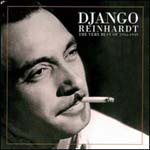 The
Very Best of 1934-1939 The
Very Best of 1934-1939
Stardust
Records
There are
literally hundreds of releases compiling the early recordings of Django
Reinhardt and the Quintet of the Hot Club of France. They vary widely in
sound quality, tune selection and sequencing, but the performances are
pretty consistently fantastic. This 32-track, two-disc package on the
Stardust label is a good introduction to what makes “gypsy jazz” so
irresistibly engaging.
For the
uninitiated, Django was a Belgian gypsy born Jean Baptiste Reinhardt in
1910. At eighteen, he lost the use of two fingers on his left hand in a
fire, forcing him to create a new guitar-fretting technique. Long before
guitars were amplified, his unique acoustic sound and phrasing
influenced Charlie Christian and Les Paul. Reinhardt and his longtime
colleague, violinist Stephane Grappelli, were the most important jazz
innovators to come from Europe.
In the
earliest ground-breaking performances included here, you get not only
the virtuosic guitar playing of Reinhardt, but the equally amazing
violin pyrotechnics of Grappelli, the flawless, chunka-chunka rhythm
guitars of Joseph Reinhardt and Roger Chaput and the solid bass of Louis
Vola. Later tracks also feature horns and piano, but the “gypsy” style
remains intact.
Completists
and purists will argue that many of the Hot Club’s greatest tunes are
missing, but among the classic tracks included are “Dinah,” “Tiger Rag,”
“Lady Be Good,” “I’m Confessin’,” “Swanee River,” “Ultrafox,” “Avalon,”
“Djangology,” and “Chasing Shadows.”
top |

 The
Hot Fives and Sevens
The
Hot Fives and Sevens Early
Ellington: Complete Brunswick and Vocalion Recordings
Early
Ellington: Complete Brunswick and Vocalion Recordings The
Complete Decca Recordings
The
Complete Decca Recordings Carnegie
Hall Jazz Concert
Carnegie
Hall Jazz Concert The
Very Best of 1934-1939
The
Very Best of 1934-1939